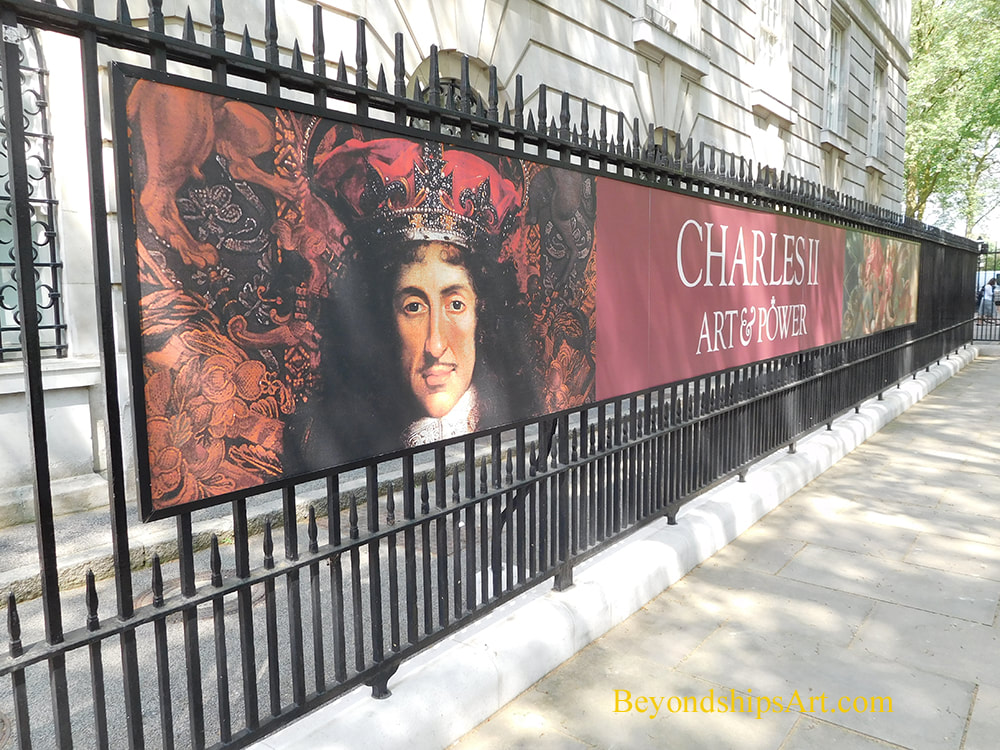|
“Charles II: Art & Power” at the Queen's Gallery (London) looks at the role of art in the reign of King Charles II (1660 to 1685).
Charles II's reign was shaped by the English Civil War. Charles's father, King Charles I, sought to be an absolute monarch. However, he came to the throne as the power of Parliament and democracy was growing in England. Eventually, this led to civil war. Charles I lost and was beheaded in London in 1649. Parliament declared the monarchy abolished and established England as a Commonwealth with Oliver Cromwell, the leader of the parliamentary army, as Lord Protector. Both to raise money and to do away with the trappings of monarchy, the royal regalia, furnishings and art collection were sold or melted down. The Commonwealth quickly fell apart following Cromwell's death. Unable to find a leader to replace Cromwell, Parliament reinstated the monarchy and invited Charles II to return from exile. Although he was welcomed back to England with great fanfare and popular sentiment, Charles realized that his position was precarious. He had seen the consequences of his father's absolutist attitude. In addition, while he was in exile, he had had to journey from country to country as various rulers' attitudes shifted from being Charles' allies to wanting to curry favor with Cromwell. As a result, Charles realized that he needed to create a public image that would help secure his position as king. One of the tools that Charles used to build this public image was art. Upon his return, Charles had an elaborate coronation. Since the royal regalia had been destroyed by the Commonwealth, he commissioned new regalia. The sumptuous pageantry connected him to the monarchs of the past and helped legitimize his reign. In addition, the Commonwealth had been heavily influenced by Puritan thinking and the people appreciated the colorful and lively ceremony. Charles and his court also commissioned works of art. Portraits showing the king, his family and his various mistresses in silks and elaborate finery hung in the various royal palaces. These were not done just for vanity but also to show that Charles and his court belonged in these palaces. At this time, collecting prints was becoming popular in England. It was the social media of the day. People purchased prints of Charles and displayed them in their homes. They were also entertained by tales of the various intrigues that were going on at court and enjoyed seeing prints of the portraits of the participants. Charles was also eager to re-build the royal art collection. His father had been a renowned collector. But beyond family sentiment, Charles wanted a first rate collection because such a collection would place him along side the established monarchs of the day. Therefore, a law was enacted calling for the return of works that had been sold by the Commonwealth. In addition, Charles purchased old master paintings and drawings. His collection grew further as a result of gifts from from other nations and courtiers seeking to ingratiate themselves with the king. Using works from the Royal Collection, this exhibition does not merely display works from the time of Charles II but presents them so that their use as a tool of the king is clear. The signage and the audio guide (included in the price of admission) also help to support the presentation of the thesis of the exhibition. Unlike his father who had had the services of Sir Anthony Van Dyck, Charles did not have an artist of genius to do his portraits. Sir Peter Lely and his contemporaries were good draftsmen but their portraits are chiefly of interest because of the people depicted rather than as independent works of art. The difference between the work of good artists and artists of genius is brought home by the examples of old master paintings and drawings collected by Charles II. These works, including works by Titian and Holbein, have an indefinable quality that the Restoration works do not. |
AuthorRich Wagner is a writer, photographer and artist. Archives
November 2018
Categories
All
|

 RSS Feed
RSS Feed